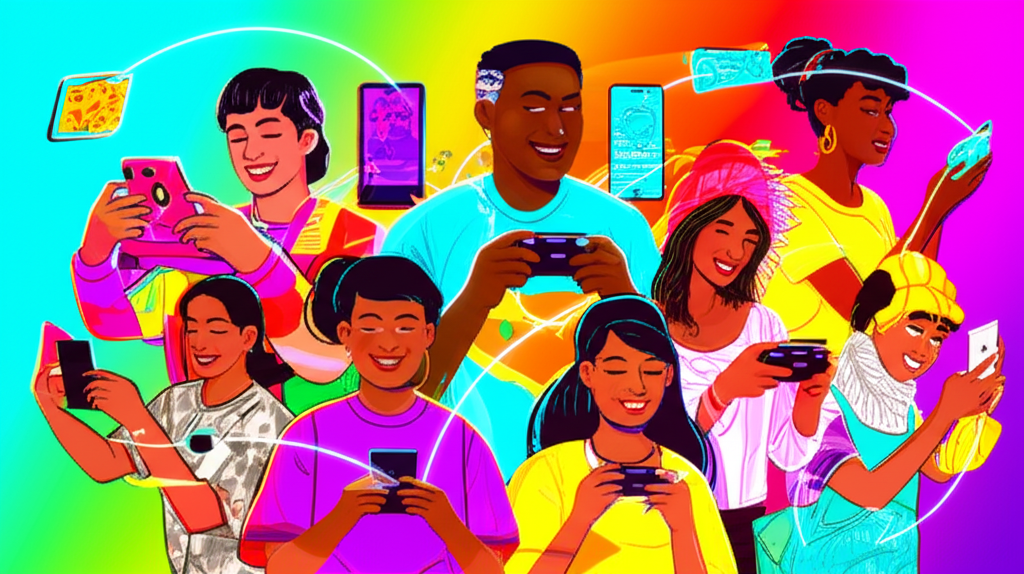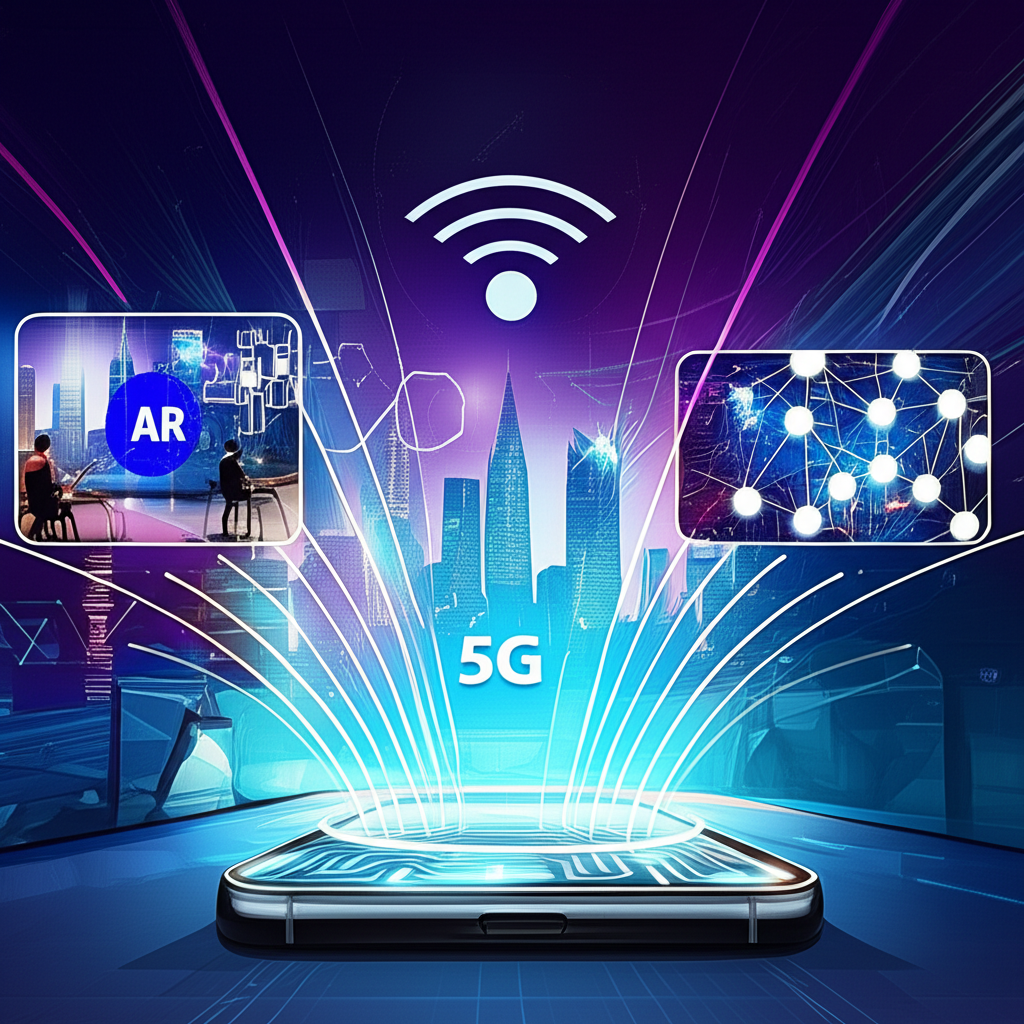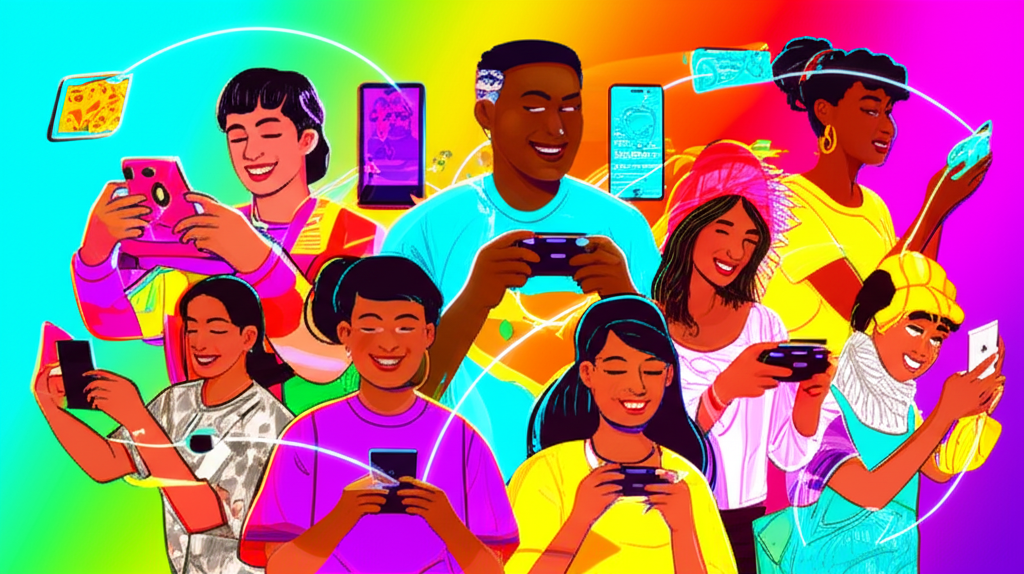Introduction: Why Mobile Gaming Commands Our Attention

What began as a niche pastime—passing time with simple puzzle games on early smartphones—has transformed into one of the most influential forces in modern entertainment. Mobile gaming is no longer just a convenient alternative; it’s the dominant platform shaping how billions interact with digital worlds. Its reach spans continents, generations, and socioeconomic backgrounds, turning everyday devices into portals for play, competition, and connection. Today, the conversation has shifted from whether mobile gaming will lead the future to how deeply it will integrate into every facet of digital life. This article explores the full scope of mobile gaming’s ascent: its market dominance, technological accelerators, the rise of serious players, evolving business models, and its role as a convergent hub for immersive experiences. We’ll also confront the real challenges—from ethical concerns to technical constraints—that must be navigated for this growth to remain sustainable and inclusive.
The Present Powerhouse: Mobile Gaming’s Current Market Dominance

Mobile gaming isn’t just growing—it’s already won the present. In terms of both audience size and revenue, it stands unchallenged at the top of the global gaming industry. Unlike traditional platforms that require dedicated hardware and significant investment, mobile gaming leverages a device already in nearly every pocket: the smartphone. This universal access has fueled explosive growth, turning mobile into the default entry point for interactive entertainment across the world.
Unprecedented Market Share and Revenue
The financial performance of mobile gaming speaks volumes. According to Newzoo, the global mobile games market was projected to generate $90.4 billion in 2023, accounting for 49% of the total games market. To put this in perspective, mobile gaming earns more than the entire recorded music industry and rivals the box office revenue of Hollywood. This isn’t a temporary spike—it reflects a structural shift in consumer behavior. Players are increasingly choosing quick, accessible, and socially connected experiences that fit into their daily routines. Whether during a commute, a lunch break, or a quiet evening at home, mobile games offer instant engagement without the need for setup or high costs. As major publishers and independent studios alike pour resources into mobile development, the quality and ambition of these titles continue to rise, further solidifying mobile’s leadership.
Global Reach and Accessibility
Few technologies have democratized access to entertainment as effectively as the smartphone. With over 7 billion mobile subscriptions worldwide, gaming is no longer limited to regions with high disposable income or advanced infrastructure. In emerging economies like India, Indonesia, and Brazil, smartphones are often the first and only personal computing device a person owns. For millions, mobile games are the gateway to digital culture, storytelling, and online communities. This widespread adoption has also diversified the gaming landscape. Developers are creating content that reflects local myths, languages, and social dynamics, resulting in a richer, more inclusive ecosystem. From hyper-localized battle royale modes to region-specific events in global titles, mobile gaming is not only global in reach but increasingly global in voice.
Technological Accelerators: Fueling Mobile Gaming’s Evolution

The rise of mobile gaming is not just about accessibility—it’s powered by a wave of technological innovation that continues to push boundaries. As mobile hardware, connectivity, and software capabilities evolve, so too does the potential for deeper, more immersive gameplay. These advancements are not incremental; they’re foundational shifts that are redefining what mobile devices can do.
The 5G Revolution: Speed, Latency, and Cloud Gaming
5G is more than just faster internet—it’s a catalyst for a new era of mobile gaming. With download speeds up to 100 times faster than 4G and latency reduced to just a few milliseconds, 5G enables real-time, high-bandwidth experiences that were once impossible on mobile networks. This leap is especially transformative for multiplayer games, where split-second reactions determine victory. More importantly, 5G makes cloud gaming a viable reality. Services like Xbox Cloud Gaming and NVIDIA GeForce NOW stream high-end games directly to smartphones, bypassing the limitations of on-device processing power. Players can now enjoy titles like *Halo Infinite* or *Cyberpunk 2077* on their phones, with the same fidelity as on a console or PC. As 5G coverage expands and network reliability improves, the distinction between local and streamed gaming will blur, opening the door to a truly portable AAA experience.
Augmented Reality (AR) and Virtual Reality (VR) Integration
While standalone AR and VR headsets remain niche due to cost and complexity, smartphones are already the most widely used devices for immersive experiences. *Pokémon GO* demonstrated the cultural and commercial potential of AR, turning city streets into interactive playgrounds and driving over $5 billion in revenue since launch. Today’s smartphones come equipped with advanced cameras, motion sensors, and depth detection, enabling richer AR experiences—from virtual furniture placement in retail apps to location-based storytelling in games. Developers are now building more sophisticated AR mechanics, such as persistent world anchors and multiplayer spatial awareness, which allow digital objects to remain in place across sessions and be shared between users. Meanwhile, mobile VR, though limited by screen resolution and processing power, continues to evolve. Entry-level headsets like Google Cardboard introduced millions to virtual environments, and newer standalone devices powered by mobile chipsets are expanding what’s possible. The convergence of AR, VR, and mobile computing will likely give rise to hybrid experiences that blend physical and digital realities in seamless, engaging ways.
Artificial Intelligence (AI) in Game Development and Player Experience
Artificial intelligence is quietly transforming mobile gaming behind the scenes. On the development side, AI accelerates content creation through procedural generation—automatically building levels, quests, or entire worlds based on algorithmic rules. This allows indie teams to create expansive experiences without massive budgets. In gameplay, AI powers smarter NPCs that adapt to player behavior, creating more dynamic and challenging encounters. For example, in strategy games, AI opponents can learn from past matches and adjust their tactics, making each playthrough feel fresh. Beyond the game itself, AI enhances personalization. Recommendation engines analyze player habits to suggest new games or in-game content, increasing engagement and satisfaction. Publishers also use machine learning to optimize ad placements and monetization strategies without disrupting the user experience. Perhaps most crucially, AI-driven anti-cheat systems are becoming essential in competitive mobile titles, detecting suspicious patterns and ensuring fair play in large-scale esports tournaments. As AI models become more efficient and compact, their integration into mobile games will only deepen.
Beyond Casual: The Rise of the “Prosumer” Mobile Gamer

Gone are the days when mobile gaming was synonymous with casual, tap-to-play diversions. A new generation of players—what some call “prosumers”—are treating mobile devices as serious gaming platforms. These users demand high performance, deep mechanics, and professional-grade tools. They invest time, money, and emotion into their mobile gaming experiences, blurring the lines between mobile, console, and PC gaming.
High-Fidelity Graphics and Console-Quality Titles
Modern mobile GPUs and system-on-chip architectures rival those of previous-generation consoles. Games like *Genshin Impact*, *Call of Duty: Mobile*, and *PUBG Mobile* deliver cinematic visuals, complex physics, and multiplayer modes that support hundreds of players in real time. *Genshin Impact*, developed by miHoYo, has become a global phenomenon, blending open-world exploration with gacha mechanics and live-service updates. Its success proves that mobile gamers are willing to engage with deep narratives, expansive worlds, and long-term progression systems. These titles are no longer side projects—they are flagship franchises with dedicated development teams, global marketing campaigns, and multi-year roadmaps. As mobile chipsets continue to advance, the gap between mobile and console graphics will shrink even further, enabling next-gen experiences on handheld devices.
Specialized Hardware and Accessories: Elevating the Experience
The rise of prosumer gamers has fueled a booming ecosystem of mobile gaming accessories. Devices like the Backbone One and Razer Kishi turn smartphones into handheld consoles, offering physical buttons, analog sticks, and trigger controls that far surpass touchscreen input. These controllers are designed for comfort during extended sessions and often include passthrough charging, so players don’t have to choose between playtime and battery life. Beyond controllers, dedicated gaming phones from brands like ASUS ROG and Black Shark offer competitive advantages: 144Hz or higher refresh rate displays for smoother visuals, vapor chamber cooling systems to prevent thermal throttling, and ultrasonic shoulder triggers for faster response times. Some models even feature customizable RGB lighting and gaming modes that prioritize performance over battery efficiency. Even accessories like clip-on cooling fans and high-capacity battery packs have become common among serious players, signaling a cultural shift toward treating mobile gaming as a performance-driven pursuit.
Mobile Esports: From Niche to Mainstream Spectacle
Mobile esports has exploded in popularity, particularly in Asia, Southeast Asia, and Latin America. Titles like *Mobile Legends: Bang Bang*, *Free Fire*, and *PUBG Mobile* host international tournaments with million-dollar prize pools and millions of live viewers. The *PUBG Mobile Global Championship 2023*, for instance, attracted over 5 million concurrent viewers at its peak, rivaling major PC esports events. What sets mobile esports apart is its accessibility. Anyone with a mid-range smartphone and a stable internet connection can compete, lowering the barrier to entry compared to high-end PC setups. This inclusivity has fostered grassroots talent pipelines, with young players rising from local cafes to global stages. Major organizations like Team Liquid and T1 have established mobile divisions, while sponsors from energy drinks to telecom companies are investing heavily. As production quality improves and regional leagues expand, mobile esports is cementing its place as a legitimate and enduring form of competitive entertainment.
The Evolving Business of Mobile Gaming: Monetization and Engagement
With millions of games vying for attention, the business of mobile gaming has become a sophisticated blend of creativity, data science, and psychology. Developers must not only create compelling experiences but also design sustainable revenue models that keep players engaged over time.
Innovative Monetization Models
While in-app purchases remain central, the industry has moved beyond simple pay-to-win schemes. Battle passes, popularized by games like *Fortnite* and now standard in mobile titles, offer players a tiered reward system for completing challenges and logging in daily. This model encourages long-term engagement while generating steady revenue. Subscription services like Apple Arcade and Google Play Pass provide an alternative path, offering ad-free, premium games for a flat monthly fee. These services appeal to players who value quality and dislike intrusive monetization. Ad-based revenue still thrives, especially in hyper-casual games, where short play sessions make rewarded video ads a natural fit. The key challenge lies in balancing profitability with fairness. Overly aggressive monetization—such as loot boxes with low drop rates—has drawn regulatory scrutiny in multiple countries. The most successful developers now focus on value-driven models, where players feel rewarded for their time and spending.
User Acquisition and Retention Strategies
In a saturated market, acquiring and retaining users requires precision. Developers use advanced analytics to track player behavior, identifying drop-off points and optimizing onboarding flows. A/B testing is standard practice, allowing studios to refine everything from UI layouts to reward schedules. Live-service design has become essential: regular content drops, seasonal events, and limited-time modes keep the experience fresh. Games like *Clash Royale* and *Brawl Stars* update weekly, introducing new characters, maps, and game modes to maintain momentum. Community engagement is equally important. In-game chat, guild systems, and social media presence help build loyalty and foster word-of-mouth promotion. Some developers even involve players in design decisions through surveys and beta tests, creating a sense of ownership and investment.
Mobile Gaming as a Convergent Hub: Blurring the Lines
Mobile gaming is no longer an isolated platform—it’s becoming the central node in a broader digital ecosystem. As technology evolves, mobile devices are integrating with other platforms, services, and emerging digital frontiers.
Cross-Platform Play and Ecosystems
The future of gaming is interoperable. More titles now support cross-platform play, allowing mobile users to team up with friends on PC or console. *Minecraft*, *Fortnite*, and *Rocket League* are leading examples, offering seamless progression across devices. Cloud saves ensure that progress isn’t lost when switching platforms, enabling a truly flexible gaming lifestyle. This convergence benefits players by giving them freedom of choice and benefits developers by expanding their potential audience. It also strengthens platform ecosystems—Apple’s Game Center, Google Play Games, and Xbox Live are all investing in cross-device continuity. As 5G and cloud gaming mature, the idea of being “locked” to one device will fade, with mobile serving as the most portable entry point into a unified gaming universe.
The Metaverse and Web3 Gaming on Mobile
Mobile devices are poised to be the primary access point for the metaverse—a vision of persistent, shared virtual spaces. While still in its infancy, the metaverse concept aligns perfectly with mobile’s always-on, location-aware nature. Through AR, users could overlay digital avatars, events, or storefronts onto physical environments, creating hybrid experiences that blend real and virtual. Mobile wallets and blockchain integration also position smartphones as gateways to Web3 gaming. Titles like *Axie Infinity* and *The Sandbox* allow players to own in-game assets as NFTs, trade them on marketplaces, and earn cryptocurrency through gameplay. While the volatility of crypto markets and environmental concerns around blockchain remain issues, the underlying idea of player ownership and decentralized economies is gaining traction. Mobile’s ease of access makes it the ideal platform for onboarding new users into this emerging digital economy.
| Feature | Mobile Gaming | PC/Console Gaming |
|---|---|---|
| Accessibility | Extremely high (smartphones ubiquitous) | Moderate (requires dedicated hardware) |
| Market Share (Revenue) | Largest segment (~50% of global market) | Significant, but smaller than mobile |
| Hardware Cost | Low to moderate (existing phone, optional accessories) | High (console/PC purchase) |
| Portability | Highest (play anywhere) | Low (requires setup) |
| Competitive Scene | Rapidly growing esports, huge viewership | Established esports, dedicated audience |
| Monetization Models | IAPs, subscriptions, ads, battle passes | Game sales, subscriptions, DLC, battle passes |
Challenges and Ethical Considerations for Mobile Gaming’s Future
Despite its success, mobile gaming faces significant hurdles that could impact its long-term sustainability and public perception.
Technical Hurdles: Device Fragmentation and Battery Life
Android’s open ecosystem is both a strength and a challenge. With thousands of device models, screen sizes, and hardware configurations, ensuring consistent performance across all devices is a major burden for developers. A game that runs smoothly on a flagship phone may stutter or crash on a budget model, leading to negative reviews and lost users. This fragmentation increases development and testing costs, often forcing studios to prioritize high-end devices and leave others behind. Battery life is another persistent issue. High-performance games can drain a smartphone’s battery in under an hour, limiting play sessions and requiring frequent charging. While hardware improvements help, software optimization and thermal management remain critical areas for innovation.
Responsible Gaming and Player Wellbeing
The very features that make mobile games engaging—constant notifications, reward loops, and social pressure—can also contribute to overuse. Concerns about gaming addiction, especially among younger players, have prompted regulatory action in countries like China and South Korea. Loot boxes, which resemble gambling mechanics, have faced bans or restrictions in several markets. Developers and platform holders must take a proactive role in promoting healthy habits. Features like screen time tracking, daily play limits, and parental controls are now standard on major platforms. Some games even include in-session reminders to take breaks. As mobile gaming becomes more immersive and persistent, the industry must balance engagement with responsibility, ensuring that play remains a positive, voluntary experience.
| Year | Mobile Gaming Revenue (Billions USD) | Global Games Market Share (%) |
|---|---|---|
| 2021 | ~90.7 | 52% |
| 2022 | ~92.2 | 50% |
| 2023 (Est.) | ~90.4 | 49% |
| 2026 (Proj.) | ~105.1 | 48% |
Conclusion: The Undeniable Future of Mobile Gaming
Mobile gaming has evolved from a novelty into the cornerstone of global entertainment. Its dominance in revenue and reach, powered by universal accessibility and relentless innovation, is unmatched. The emergence of prosumer gamers, supported by high-end hardware and competitive ecosystems, signals a lasting shift in perception—from casual pastime to serious platform. As mobile integrates with cloud gaming, AR/VR, AI, and Web3, it’s becoming a central hub for digital interaction, blurring the boundaries between games, social media, and virtual economies. While challenges like device fragmentation, battery limitations, and ethical concerns remain, the trajectory is clear. Mobile gaming is not just the future—it’s already here, shaping how we play, connect, and experience digital life on a global scale.
Is mobile gaming the future of gaming, or just a temporary trend?
Mobile gaming is unequivocally the future of gaming, not merely a temporary trend. Its massive market share, global accessibility, continuous technological advancements (5G, AR/VR, AI), and the rise of “prosumer” players and esports indicate a permanent and expanding presence in the entertainment landscape. It’s evolving into a central hub for all digital interactive experiences.
What specific technologies are driving the growth and evolution of mobile gaming?
Several key technologies are propelling mobile gaming forward:
- 5G Connectivity: Enables faster downloads, lower latency, and seamless cloud gaming.
- Augmented Reality (AR) & Virtual Reality (VR): Creates immersive and interactive experiences, blending digital content with the real world.
- Artificial Intelligence (AI): Enhances game development, creates more dynamic NPCs, personalizes content, and improves anti-cheat systems.
- Advanced Mobile Chipsets: Allows for console-quality graphics and complex gameplay on smartphones.
- Cloud Gaming: Streams high-fidelity games directly to mobile devices, reducing reliance on local hardware power.
How does mobile gaming compare to PC and console gaming in terms of market size and innovation?
Mobile gaming currently dominates the global games market in terms of revenue and player base. For instance, Statista reports that the mobile gaming segment consistently generates more revenue than PC and console gaming combined. In terms of innovation, mobile gaming is a hotbed for new monetization models, accessibility features, and the integration of emerging technologies like AR/VR and Web3, often setting trends that later influence traditional platforms.
Will mobile gaming ever fully replace traditional gaming platforms?
It’s unlikely mobile gaming will fully *replace* PC and console gaming. Instead, it’s more probable that these platforms will coexist and increasingly integrate. Mobile gaming’s strength lies in its accessibility and portability, while PC and console gaming offer dedicated, high-performance experiences. The trend is towards cross-platform play and unified ecosystems, allowing players to choose the best device for their current situation rather than being limited to one.
What are the biggest challenges facing the mobile gaming industry in the coming years?
Key challenges include:
- Device Fragmentation: Optimizing games for a vast array of hardware specifications.
- Battery Life: The constant demand for more power impacting device endurance.
- User Acquisition and Retention: Standing out in an extremely crowded app market.
- Monetization Ethics: Balancing revenue generation with fair play and avoiding predatory practices.
- Player Wellbeing: Addressing concerns around addiction and promoting responsible gaming habits.
How are monetization models in mobile gaming expected to change in the future?
Monetization models will continue to evolve towards more diverse and player-friendly approaches. Expect continued refinement of subscription services (like Apple Arcade), battle passes, and potentially more integration of Web3 elements such as NFTs and play-to-earn mechanics that offer true digital ownership. The focus will be on long-term engagement and value creation for players, moving beyond aggressive one-time purchases.
What role will augmented reality (AR) and virtual reality (VR) play in future mobile games?
AR and VR will play an increasingly significant role. Mobile AR will become more sophisticated, integrating deeper with real-world environments and offering more interactive gameplay than simple overlays. Smartphones will also serve as accessible gateways to mobile VR experiences, either through dedicated headsets or as companion devices for more advanced AR/VR systems, creating new dimensions of immersive play.
Are mobile games losing popularity among core gamers, or are they attracting a new audience?
Mobile games are not losing popularity; rather, they are attracting an increasingly diverse audience, including a growing segment of “prosumer” or hardcore gamers. With the rise of console-quality titles, specialized hardware, and professional mobile esports, dedicated gamers are finding compelling experiences on mobile, alongside the casual audience that has always been a cornerstone of the platform.
What are some examples of cutting-edge mobile gaming hardware and accessories?
Cutting-edge mobile gaming hardware and accessories include:
- Gaming Smartphones: Devices like ASUS ROG Phone or Black Shark series, featuring high refresh rate displays, advanced cooling, and gaming-centric controls.
- External Controllers: Attachments such as Backbone One or Razer Kishi, transforming phones into dedicated handheld consoles.
- Mobile Triggers: Physical buttons that clip onto phones for improved tactile feedback.
- Cooling Systems: External fans or Peltier coolers designed to prevent overheating during intense gaming sessions.
- High-Performance Earbuds/Headsets: Low-latency audio solutions optimized for mobile gaming.
How is mobile gaming impacting social interaction and community building globally?
Mobile gaming profoundly impacts social interaction by connecting billions of players worldwide. Multiplayer games foster global communities, enabling friends and strangers to play together regardless of location. Mobile esports create shared spectacles, uniting fans and players. Additionally, many mobile games incorporate robust social features, chat functions, and guild systems, enhancing digital literacy and providing new avenues for social engagement and community building on a global scale.

留言